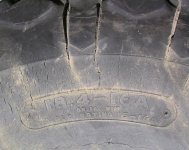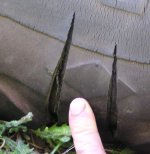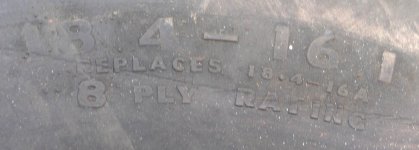CliffordK
Veteran Member
- Joined
- Mar 8, 2013
- Messages
- 1,768
- Location
- Eugene, Oregon
- Tractor
- Toro D200, Ford 1715, International 884,
Ok,
Looking at the tires on my not-quite-new baler.
They have some mild weather checking, so I was thinking of hunting down some replacements.
Size is:
18.4-16A
on a 16" rim
6 Ply Rating 15-16A (Right)
8 Ply Rating 15-16A (Left) (different ply rating is "factory" according to parts manual).


Pinky in photo for reference.
So, what does the 16A mean?
The most common Ag (Turf) tire size is 18.4-16.1
That would mean the tire is just under 1/8" larger than a 16" tire, right?
that doesn't seem to be a big difference, especially with a "new" tire that would have some flexibility, although a used one already mounted on a 16.1" rim might have lost some of that flexibility If I powder-coated the rims, I might be able to get at least 1/16" overall buildup. And, I will probably keep tubes in them. I don't know if they have rubber rim guards.
But, what does the 16A mean?
I might be able to find some used 16" super swampers.
Looking at the tires on my not-quite-new baler.
They have some mild weather checking, so I was thinking of hunting down some replacements.
Size is:
18.4-16A
on a 16" rim
6 Ply Rating 15-16A (Right)
8 Ply Rating 15-16A (Left) (different ply rating is "factory" according to parts manual).


Pinky in photo for reference.
So, what does the 16A mean?
The most common Ag (Turf) tire size is 18.4-16.1
That would mean the tire is just under 1/8" larger than a 16" tire, right?
that doesn't seem to be a big difference, especially with a "new" tire that would have some flexibility, although a used one already mounted on a 16.1" rim might have lost some of that flexibility If I powder-coated the rims, I might be able to get at least 1/16" overall buildup. And, I will probably keep tubes in them. I don't know if they have rubber rim guards.
But, what does the 16A mean?
I might be able to find some used 16" super swampers.
